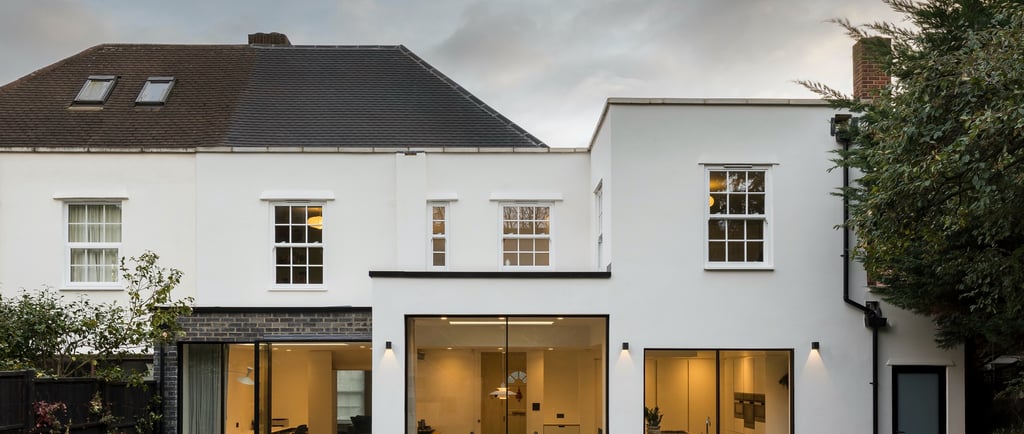Double Storey Extension UK 2025 | Costs, Planning & Ideas
5/11/20253 min read


Double-Story Extension in the UK: The Ultimate 2025 Guide
Looking to add serious space and value to your home? A double-story extension could be the most cost-effective and impactful way to transform your living space. Whether you’re after a bigger kitchen, extra bedrooms, a home office, or even a new en-suite, this extension type ticks all the boxes.
In this in-depth guide, we explore everything you need to know about double-story extensions in the UK, including costs, planning permission rules, building regulations, and the latest design ideas for 2025.
What Is a Double-Story Extension?
A double-storey extension adds space across two floors of your home. Most homeowners use the ground floor for extended living areas like kitchens and lounges, while the upper floor adds bedrooms or bathrooms.
This type of extension maximizes your home’s footprint without taking up twice the land space—offering great value for money per square meter.
Why Choose a Double-Story Extension?
Here are some key advantages:
🏠 Maximise space vertically instead of sprawling out
💷 Cheaper per m² than building two single-storey extensions
🛏️ Adds multiple rooms in one build—ideal for growing families
📈 Boosts property value significantly (up to 25% or more)
📐 Offers flexibility for open-plan living, en-suites, or home offices
How Much Does a Double-Storey Extension Cost in the UK (2025)?
Cost depends on location, materials, and design complexity. Here’s a general estimate:
Cost per m² in Greater London: £2,800–£4,000
Total (40m² typical size) in Greater London: £112,000–£160,000
Cost per m² Outside London: £2,200–£3,000
Total cost (40m² typical size) in Greater London: £88,000–£120,000
Don’t forget extras like kitchen fittings, bathroom suites, structural calculations, architect/design fees, and VAT.
Do You Need Planning Permission for a Double-Story Extension?
Unlike single-storey builds, double-story extensions often require full planning permission, especially if:
The extension is higher than the existing eaves
It is closer than 7m to the rear boundary
It changes the appearance of the front elevation
You're in a conservation area or listed building
Key Planning Tips:
Use materials that match or complement your existing house
Maintain neighbour privacy (no large side-facing windows)
Keep the ridge height in line with your existing roofline
Always consult with your local planning authority or hire a planning consultant to ensure compliance.
Building Regulations for Double-Storey Extensions
All double-story extensions must meet UK Building Regulations, including:
Structural stability (Part A) – load-bearing walls, foundations, steel beams
Fire safety (Part B)—escape routes, smoke alarms, fire doors
Sound insulation (Part E)—especially between floors
Thermal efficiency (Part L)—insulation, double glazing
Drainage and ventilation (Parts H & F)
You’ll need a building control officer to inspect the build at key stages and issue a completion certificate.
Design Ideas for Double-Story Extensions (2025 Trends)
Ground Floor:
Large open-plan kitchen diner with skylights and bifold doors
Utility room + downstairs WC for added convenience
Garden-facing lounge with full-height glazing
First Floor:
Master bedroom with en-suite
Additional children’s bedroom or nursery
Home office or guest bedroom
Walk-in wardrobe or dressing area
Popular Design Features:
Full-height windows or Juliet balconies
Light wells or glass links for natural light
Brickwork or cladding to modernise external look
Air source heat pumps or underfloor heating systems
Construction Timeline
A double-story extension usually takes 16 to 24 weeks, depending on complexity, weather, and permissions.
Estimated Time of Different Stages:
Design & planning 4–6 weeks
Planning approval 8–12 weeks (if needed)
Build phase 12–20 weeks
Finishing & inspection 2–4 weeks.
Common Pitfalls to Avoid
🔧 Skipping structural calculations—always involve a structural engineer
🧱 Using materials that don’t blend well with existing architecture
🧾 Not informing your mortgage provider or home insurer
🤝 Not serving a Party Wall Notice if you share a wall with a neighbour
💡 Underestimating lighting or power needs on both floors
Frequently Asked Questions
Q: Can I live in my home during a double storey extension build?
Yes, but expect disruption. Builders often install temporary partitions to separate the work zone.
Q: Will I need a Party Wall Agreement?
If your build affects a shared wall or boundary—yes.
Q: Can I build over a garage or existing extension?
Possibly—but you’ll need a structural assessment to confirm feasibility.
Will a Double-Story Extension Add Value?
Absolutely. In many UK regions, especially London and the South East, a well-executed double storey extension can add £100,000 or more to your home’s value. It’s especially attractive to families looking for more space without the cost of upsizing.
Final Thoughts
A double storey extension is one of the smartest investments you can make in your home. It provides ample space, modern functionality, and significant added value. With careful planning, a clear budget, and the right professionals, your 2025 home transformation could be more achievable than you think.